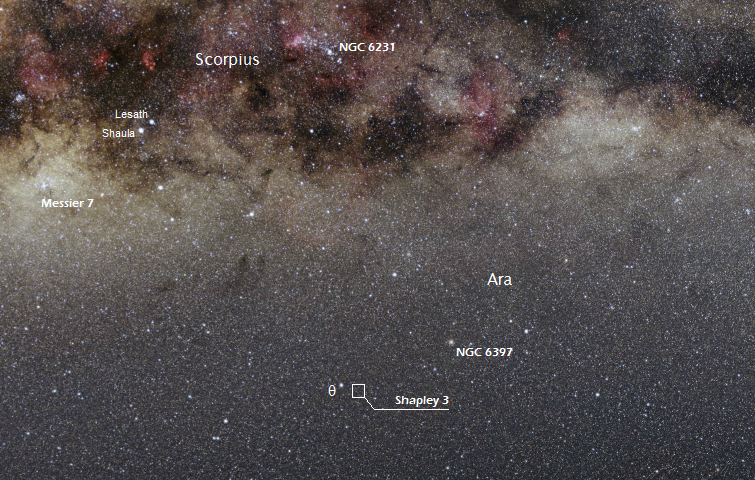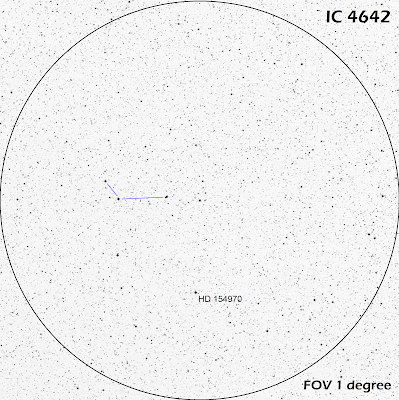Some Fascinating Planetaries Inhabit
the Constellations of the Winter Southern Skies
Part II. Ring planetary nebulae
A winter starry night anywhere in the Southern Hemisphere shows a region in the sky, between Right Ascension 12 and 19hs, where some constellations like Crux, Centaurus, Norma, Ara, and Sagittarius host some interesting planetary nebulae. The four objects included in part I of this article are bipolar planetaries, one of the five types in the morphological classification by Schwars et al. (1992), i.e. Elliptical (e), Bipolar (b), Point symmetrical (p). Irregular (i), Stellar (st). Part II of "Intriguing Planetary Nebulae" is devoted to the so-called ring or annular planetaries. Below there are three good examples of this kind of planetary nebula. As an observer, you surely know the Vorontsov-Velyaminov classification which classifies ring-shaped objects as type 4.
If you have at least an 8-inch telescope, all of the planetaries mentioned in this article are visible. Of course, you will be able to find more features or analyze their morphologies in more detail if you observe them through bigger instruments.
A winter starry night anywhere in the Southern Hemisphere shows a region in the sky, between Right Ascension 12 and 19hs, where some constellations like Crux, Centaurus, Norma, Ara, and Sagittarius host some interesting planetary nebulae. The four objects included in part I of this article are bipolar planetaries, one of the five types in the morphological classification by Schwars et al. (1992), i.e. Elliptical (e), Bipolar (b), Point symmetrical (p). Irregular (i), Stellar (st). Part II of "Intriguing Planetary Nebulae" is devoted to the so-called ring or annular planetaries. Below there are three good examples of this kind of planetary nebula. As an observer, you surely know the Vorontsov-Velyaminov classification which classifies ring-shaped objects as type 4.
If you have at least an 8-inch telescope, all of the planetaries mentioned in this article are visible. Of course, you will be able to find more features or analyze their morphologies in more detail if you observe them through bigger instruments.
Shapley 1
 |
The observing site in Pampa El Leoncito. The dome of the 2.15m telescope
of CASLEO observatory is visible in the middle of the photo. CASLEO is situated about 14kms from this site in a straight line. |
I observed this planetary in two nights from a very dark site just a few kilometers north of CASLEO observatory in San Juan province, Argentina, in the majestic Andes mountain range. The first night was good enough to carry out deep-sky observation but the seeing was not as good as the second night. Even a cold wind bothered most of the night.
After aiming the telescope to the zone where Shapley 1 lies (see map above) I could found the 1-degree field of view surrounding the planetary. Shapley 1 is situated between the stars labeled with circles in Figure 1. The three stars linked with a red line helped for an accurate search of the position of the planetary as it forms a "rhombus" with them.
At 63x without a nebular filter, the planetary is not visible (at least that night under the aforementioned conditions). However, a UHC filter helps to detect the ghostly image of Shapley 1. It can be barely glimpsed using averted vision appearing like a very faint nebulosity rather smooth in brightness. The target was low in the sky for a more detailed observation that night (around 25°), so I decided to make another observation the following night.
A new observation earlier in the second night (at the end of the local astronomical twilight) made possible to see the planetary higher in the southwest sky (37°). This higher altitude plus a more steady sky made possible a better detection and view of this Milky Way object. At 63x, Shapley 1 could be glimpsed even without a nebular filter, looking like a very faint, roundish, and hazy smooth patch. Applying a UHC filter the view definitively improves. Through this kind of filter, the object is undoubtedly visible. Averted vision makes possible to detect, for brief moments, the west edge appearing slightly brighter than the rest of the planetary (indicated with A in Figure 2).
 |
Figure 2. DSS image of Shapley 1 showing its annular shape.
North is up. East to the left.
|
Shapley 3
 |
Position of the peculiar planetary nebula Shapley 3 in the winter southern sky.
Picture taken using the Photopic Sky Survey ©Nick Singer.
|
 |
Figure 1. DSS image of Shapley 3. The gray circles on the image indicate areas of
brighter stars
|
Using the Optimum Magnification Methods and considering that a visual magnitude of 11.9 and an angular size of 0.6 arcmin are accurate values, the optimum magnification to detect this Milky way´s nebula is 100x for an 8-inch telescope working under a 6.2 limiting magnitude sky. So, let`s see what I could see at different magnifications from a site that offers not exceptionally dark skies but dark enough to carry out this kind of observation.
 |
| Figure 2. DSS image of Shapley 3 and its surrounding stars |
At 78x the faint neighboring stars are better viewed so it is easier to identify Shapley 3 in the field. Now the planetary nebula looks, even with direct vision, like a faint and small nebulosity surrounding a central star, which jumps to the view more easily when applying averted vision. With a UHC filter, the view is very different. It improves the view of the planetary a lot, appearing still faint but with a clear nebular nature, round, and rather smooth in brightness. For moments the central region appears brighter because of the presence of the central star. The view through the Orion Ultrablock filter is not so useful as that with the UHC filter. Shapley 3 does not appear so detached as with UHC. The central star is better viewed, always surrounded by subtle nebulosity.
 |
| Shapley 3. Image from Simbad database |
I got similar results after observing Shapley 3 with a little higher power (148x). However, the planetary appears even fainter, especially through the UHC filter. Orion Ultrablock offers a not so detached view of this object when comparing with UHC.
IC 4642
 |
| IC 4642 is a faint planetary nebula situated in constellation Ara, not so far from NGC 6397, one of the nearest globular clusters. Picture taken using the Photopic Sky Survey ©Nick Singer. |
 |
| IC 4642 ©R. Corradi et al. |
This 15" size object is immersed in a field that shows several faint stars. Some brighter stars are visible in the east half of the field of a telescope working at low magnification. In a 1-degree field, the brightest star is the 8.3 magnitude HD 154970. The stars linked with a blue line in Figure 1 are useful to find the planetary which forms a sort of "question mark" shape along with four faint stars of 11 and 12 magnitude (linked with pale blue lines on Figure 2 below). The 12 visual magnitude variable star V788 Arae, a semi-regular pulsating star according to the Simbad Database, is indicated in Figure 2 with a blue arrow. To use that asterism makes the identification of IC 4642 very easy. At low magnification (63x) and without any nebular filter IC 4642 is visible, appearing like a very small hazy disc that can be glimpsed even with a direct vision.
 |
| Figure 1 |
Jumping to a higher magnification (118x) the view of IC 4642 is more obvious at the eyepiece, clearly looking like a small, round nebulosity among the surrounding stars. Through a UHC filter, the view is definitively beautiful with the planetary detached against the background sky, rather smooth in brightness, and circular in shape. An Orion Ultrablock filter also improves the view, which is pretty similar to that obtained with the UHC filter but somewhat brighter through an 8-inch telescope.
This power (160x) makes the planetary to appear round and smooth in brightness. With averted vision the core of this object appears to look a little darker for moments, suggesting (in a rough way of course) a ring-type structure. Seeing conditions at the moment of this analysis was not the best, so it would be good to make another observation under more optimum conditions to compare results. The observation using the Orion Ultrablock shows a round and smooth nebula. Averted vision makes possible to detect what appears to be a point-like feature, slightly brighter, on its west side (indicated with a white arrow in Figure 2). It is important to say that this feature was very difficult to confirm.
 |
| Figure 2 |




